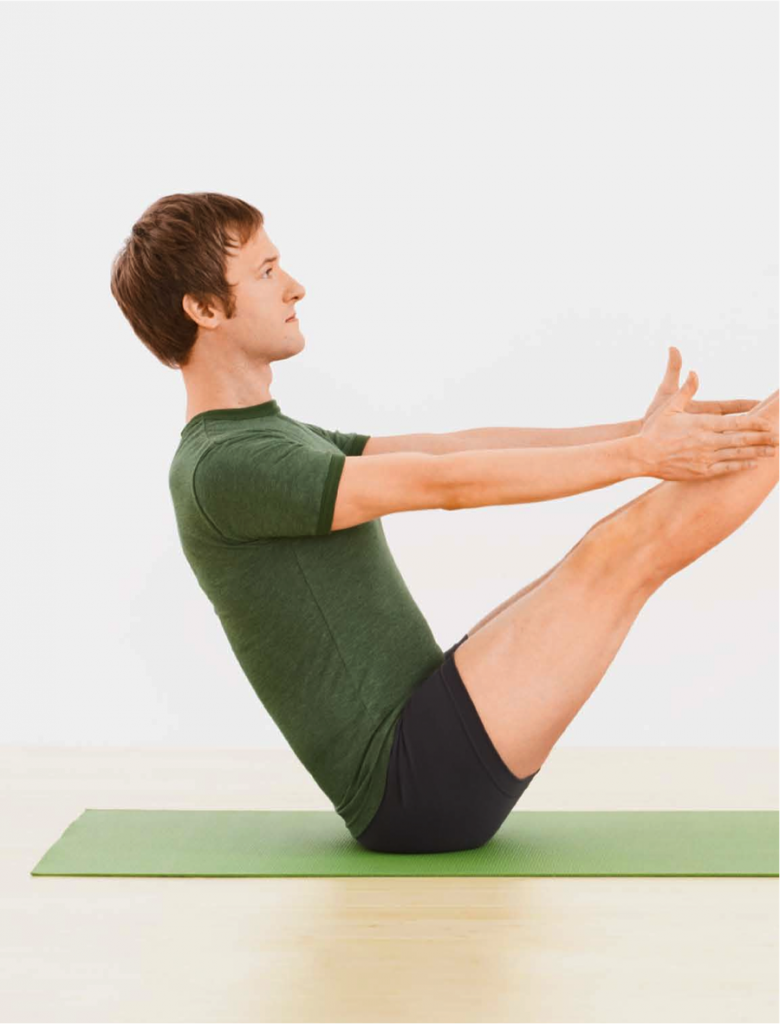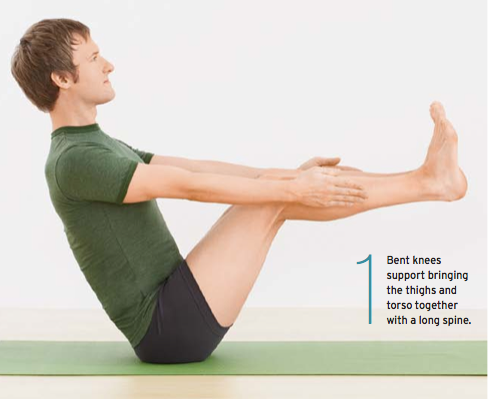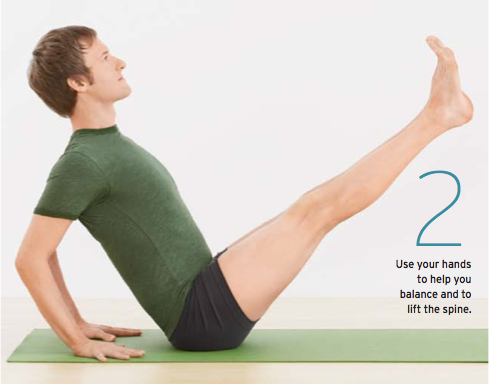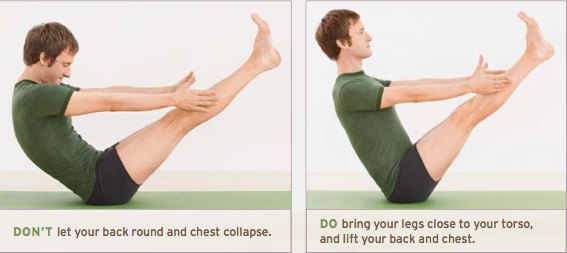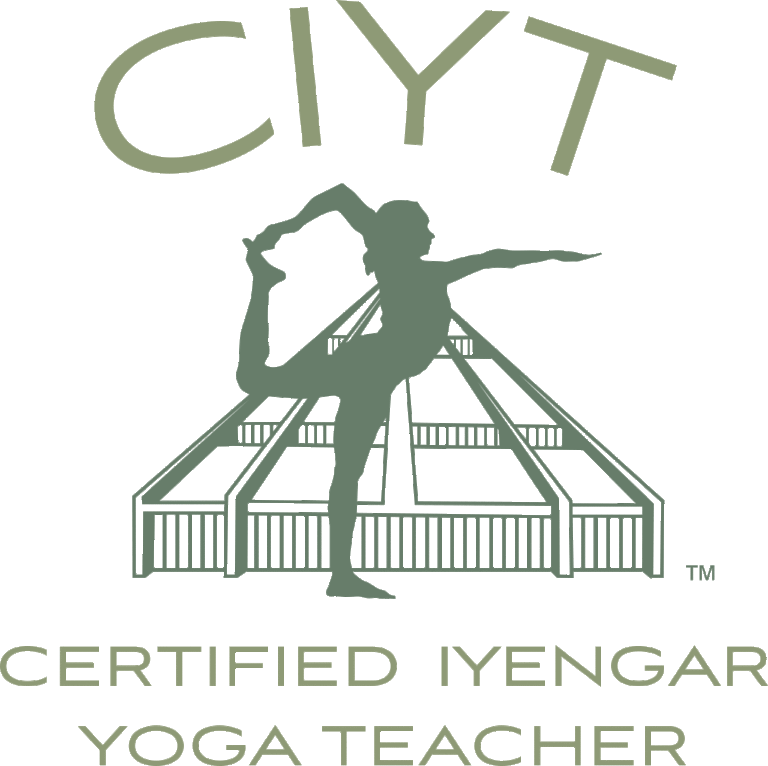We’ve all heard that strong abdominal muscles support a healthy lower back and that yoga poses build “core” strength. But, although Navasana is categorized as an abdominal pose, like all yoga asanas, on a purely physical level, Navasana does more than strengthen a single muscle group. Boat pose strengthens the back muscles and legs and most importantly, trains you in a series of actions that are essential in the practice of many asanas and pranayama techniques.
In yoga, a strong core is more than a strong abdomen, lower back, pelvis, and torso. B.K.S. Iyengar says that yoga practice should take you on an inward journey from the periphery of your body to the core of your being. As a beginner, you work with the tools that are most accessible, the outer body. As you strengthen and increase mobility in your legs and arms, you can begin to strengthen your spine and coordinate the work of your limbs with your torso, in the process, learning about your breath, attention span, emotions and the qualities of your nature. Eventually your yoga practice penetrates beyond your postural muscles, nerves, bones and organs to your inner most Self, ultimate truth. The integration of all of your body parts leaves you feeling strong and supple as well as mentally and emotionally steady, connected to your inner stable core.
In boat pose, you use your spine and abdomen to support each other and instead of shortening the front of the body to contract the abdomen, you will learn to do what seems impossible, contract and extend the abdomen simultaneously. This is no gym crunch. Instead of bringing your pelvis and chest close to each other, here you pull your ribs away from the abdomen to lift the chest, all while balancing on your buttocks. As they move closer to each other in this pose, your back and abdomen are strengthened and lengthened. The dynamics of Navasana will help with the practice of your standing poses, inversions, forward bends, and balancing poses. Even when you are standing in Tadasana (Mountain pose), firm legs and a long strong abdomen form the foundation to support your lifted chest. Navasana also makes you balance on the buttocks and helps to build strength in sitting postures.
If you have tight hamstrings, you may find it difficult to bring the legs close to the torso without rounding the back and sinking in the chest. The first variation with bent knees will give you the opportunity to practice the pose without sagging in the spine. Boat pose is like a balancing version of Dandasana, so if you find that due to tight hamstrings you cannot sit up straight in Dandasana, you will benefit from practicing the first variation. If your abdomen, back or legs are weak, you can practice the second variation with your hands on the floor to help support the lift of your spine. Even if you are not challenged with stiffness and weakness in this pose, both variations give you the opportunity to learn the pose gradually so that you can experience the dynamics of how the back, legs and abdomen work together.
BENT KNEES:
Place a blanket on top of your mat to provide some cushioning for your buttocks. Sit in Dandasana (Staff Pose) with your legs together, straight in front of you. Place your hands on the floor besides your hips, press your thighs into the floor, and stretch the heels away from your pelvis to fully straighten the legs. Lift your torso straight up away from the floor and open the chest. The back should feel like it is moving forward towards the front of the body. Lift the front of the body all the way from the bottom of your pelvis to the top of your chest. To separate your torso from your legs, press the very top of your thigh bone into the floor and lift the bottom of your abdomen up away from the thighs without tilting onto the back of your buttocks. Lift the ribcage away from the abdomen and roll the shoulders back.
Now bend your knees and place your feet on the floor. Hold the tops of your knees with your hands and pull slightly to lift the sternum. Raise your feet from the floor until the shins are parallel to the floor. Keeping your legs together, bring your thighs closer to your chest and lift your chest. Now that you are balancing on your buttocks, don’t lean back onto your spine. Pull on your knees once again to lift the chest and increase the lift of your sternum away from your navel. Without dropping the chest, stretch your arms straight forwards besides your legs, parallel to the floor, palms facing each other. Notice how your abdominal muscles engage as you pull the thighs closer to your torso. Don’t let the back round but see if you can lengthen the front of your torso even more.
Even though the arms stretch forward, the shoulders should pull back to help you engage the shoulder blades to move down and forward towards your chest. Relax your throat and look straight ahead. You can hold the pose initially for thirty seconds working up to one minute breathing normally. Then exhale and place your feet on the floor and return to Dandasana.
SECOND VARIATION:
In this variation you are going to straighten your legs in the pose while keeping your hands on the floor to help you to balance and support the lift of the spine. Start again in Dandasana. Lean slightly backwards and place your hands a few inches behind your hips on the floor. Lift your chest. Bend your knees as you did in the first variation and raise the legs until your shins are parallel to the floor. Bring the thighs close to the torso and move your back ribs and shoulder blades forwards. Keeping the thighs close to the chest, exhale and straighten your legs without rounding the back. Extend from your calves to your heels. Your feet should be higher than your head. At this point you will feel your abdomen working but don’t let the front of your body shorten. Lift your navel up toward your chest, your ribs up off of your abdomen and roll your shoulders back.
Your legs need to work hard to remain straight and uplifted. Like in Dandasana, press the front of your thigh to the back of the leg and extend your hamstrings towards your heels. Reach out through your inner heels and broaden the soles of the feet. Use your hands to help balance yourself on the buttocks without tilting back. Exhale and bend the knees and place your feet back on the floor.
FINAL POSE:
Now you will go through the stages of the previous variation to get into the final pose. If you find that your back or legs are too weak to hold yourself up without sinking in the spine, you can support your heels on a wall or tall chair and again place your hands on the floor behind you to help prop yourself up.
Start in Dandasana and again lean back on your hands, raise and straighten your legs as you did in the second variation. Now come onto your fingertips and lift your lower back so that the entire spine feels like it is moving towards the front of your body. Lift your arms and stretch them evenly forward, parallel to the floor without touching the legs. Keep your palms extended, facing each other. Stretch the fingers forward and pull your shoulders back and down as you lift your sternum.
Keep the knees firm and tight to maintain straight legs. Extend the inner legs towards your inner heels and spread the balls of the feet from the big toe towards the little toe. Without bending the knees, try raising your legs higher so that the feet lift above the level of your head. Lift your chest. Don’t pull your chin down towards the chest but keep your throat soft and open and look straight ahead. Hold the pose for thirty to sixty seconds and then exhale and release your legs to the floor. Lie down on your back to rest.
Benefits:
Bloating and gas
Strengthens the abdomen and back
Contraindications:
Pregnancy
Menstruation
Diarrhea
DON’T:
Let your back round and chest collapse.
DO:
Bring your legs close to your torso and your lift your back and chest.
CALLOUTS:
Lift your chest up and away from your abdomen
Move your back ribs forward
When your legs are straight, keep your feet at eye level or higher
Look straight ahead

